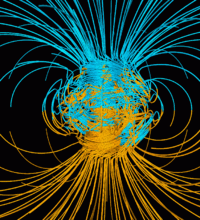
Photo from wikipedia
The cerebral venous flow distribution depends on posture and central venous pressure. Internal jugular veins (IJVs) are the major cerebral venous outflow pathway in humans in supine position. In upright… Click to show full abstract
The cerebral venous flow distribution depends on posture and central venous pressure. Internal jugular veins (IJVs) are the major cerebral venous outflow pathway in humans in supine position. In upright position, IJVs are collapsed due to their location above the heart, and the vertebral venous plexus is used as an alternative venous pathway. However, while standing, a marked increase in central venous completely reopens the IJVs. This interaction between IJVs and paravertebral venous plexus in relation to the body position has been studied on ultrasound imaging (US). US is a noninvasive imaging technique that provides high-resolution images with real-time, dynamic evaluation of structural/morphological and hemodynamic/functional venous abnormalities at relatively low cost and can be performed in both supine and upright position. However, the US probe can artifactually decrease the crosssectional area of IJV as well as extrinsically compress the omohyoid muscle due to the neck position. Moreover, venous structures communicate with each other to form complex venous networks and present some variations in their connection patterns in the cervical region. With a robust 3D imaging method, the patency, trajectory, and dimensions of the head and neck vasculature could be studied in more detail in minutes. Therefore, a tiltable low-field MRI of the cervical region at different inclination angles may give valuable information in patients whose diagnosis relies on imaging of extracranial venous pathways. In this issue of JMRI, in a pioneer pilot study, the authors measured the basic geometric characteristics and patency of the IJVs over a long trajectory, using a tiltable low-field MRI under multiple inclination angles in healthy volunteers. The results of this study bring a better understanding of the normal variation of the IJVs in the healthy situation and how this could be translated to abnormal cases, such as chronic cerebrospinal venous insufficiency (CCSVI). Fifteen healthy individuals with no prior cervical alterations were included in this study. An open 0.25-T MRI system was used to scan the participants in 90 (sitting position), 69 , 45 , 21 , and 0 (supine position) in the transverse plane with the top at vertebra C2. A gradient echo sequence was used to maximize the inflow effect in the IJVs. For the assessment, automatic centerlines through the IJVs were created to measure the diameter and patency perpendicular to the vessel at every 4 mm, starting at the level of C2. This research confirmed that tiltable low-field MRI can measure basic geometric characteristics and patency of the IJVs over a long trajectory under multiple inclination angles. The study showed that the average diameter of IJVs does not vary as a function of the height with respect to C2, but at 21 , 45 , and 69 inclination angles, and a wider variation in average diameter was found in vessels that were partially collapsed due to the presence of side branches. Increasing the angle of the patient bed, more alternative venous pathways became visible. Although alternative venous pathways could be observed in the study, their geometry could not be analyzed due to the gradient limitations on the MRI system used. As highlighted by the authors, an improvement of the MRI protocol in terms of resolution and efficient flow imaging is important in future studies to evaluate the role of smaller venous pathways under inclination. Professionals should be aware that healthy population presents normal anatomic variations of the venous paths. In patients with pathological conditions, in the case of obstructions, they would benefit from more naturally possible pathways. Therefore, studies are needed to obtain more insight in the complexity of other venous pathways than the IJVs and paravertebral plexus under multiple inclination angles. Future studies should focus on the simultaneous visualization of multiple venous pathways to make sure that all possible routes are included. Furthermore, other studies involving tiltable low-field MRI with a larger number of participants, in particular individuals with the CCSVI, are necessary to validate this imaging examination method. Also, the evaluation of the alternative pathways is needed to understand whether this
Journal Title: Journal of Magnetic Resonance Imaging
Year Published: 2022
Link to full text (if available)
Share on Social Media: Sign Up to like & get
recommendations!